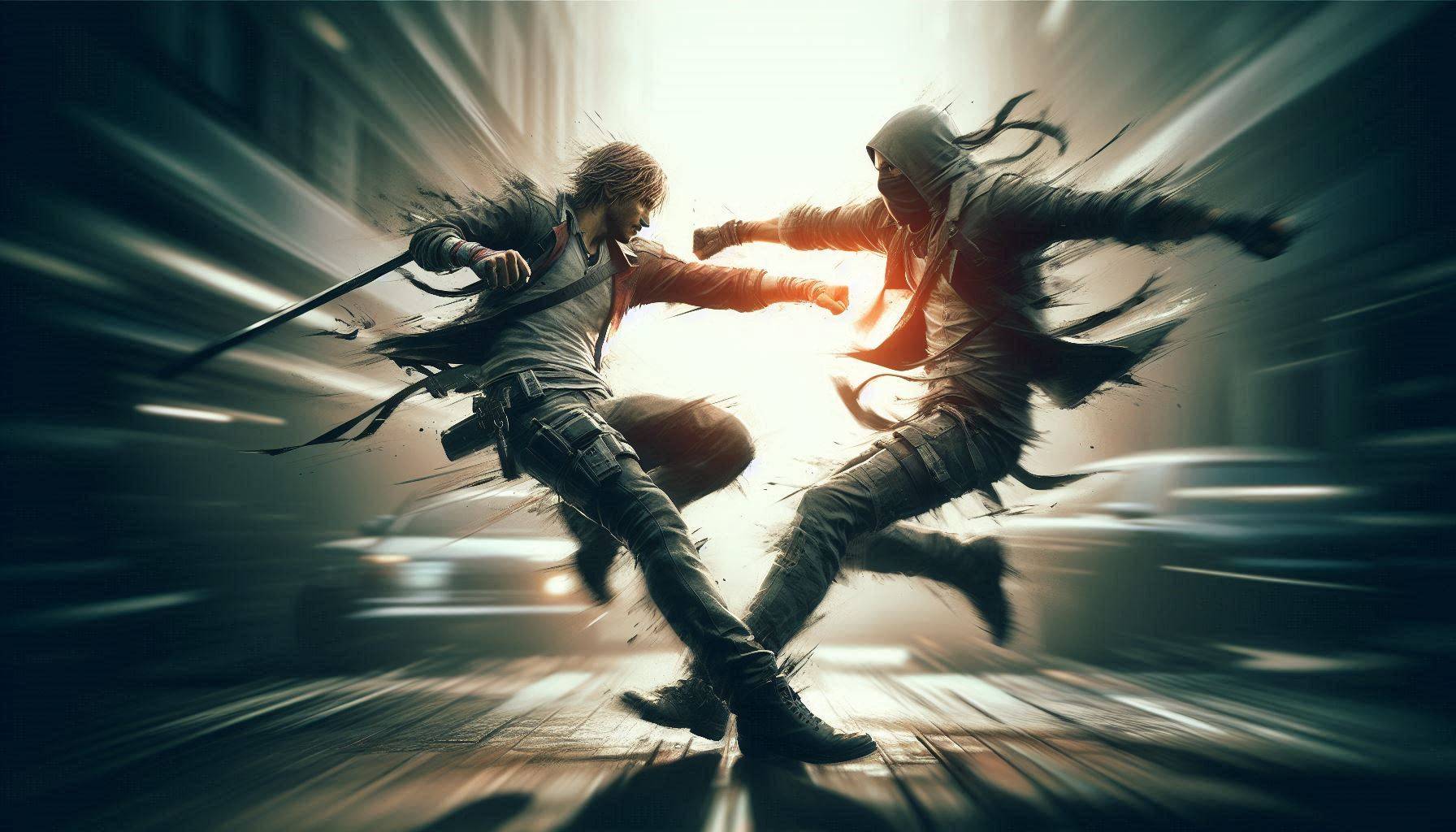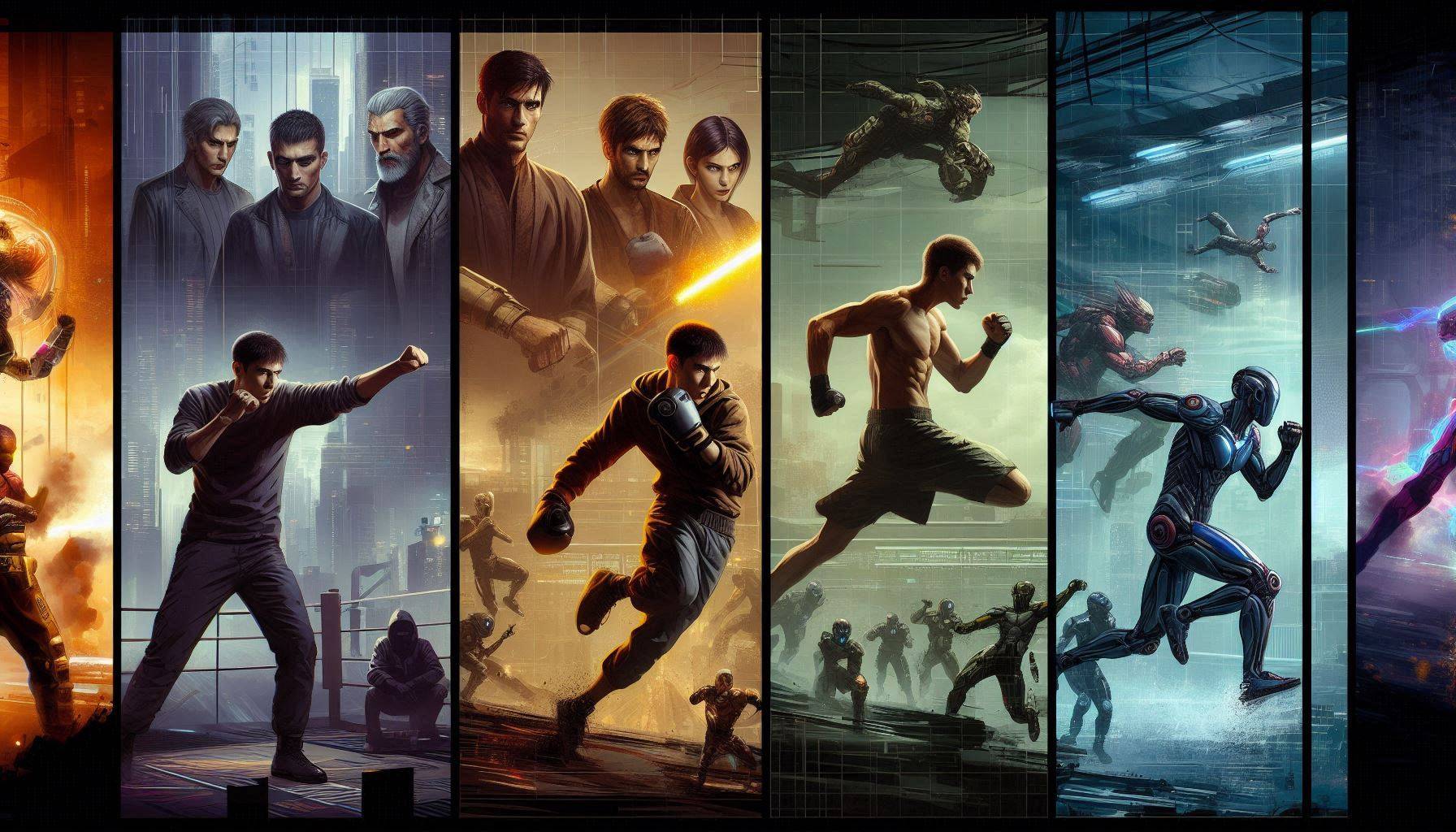From the bone-crushing intensity of John Wick’s gun-fu sequences to the balletic grace of Neo dodging bullets in The Matrix, fight scenes have become iconic moments in cinema.
Yet, for many screenwriters, crafting compelling fight sequences remains one of the most challenging aspects of the craft. How do you translate the visceral energy of combat into words on a page? How do you balance technical precision with emotional resonance?
In this comprehensive guide, we’ll explore everything you need to know about writing fight scenes that leap off the page and keep readers (and eventually audiences) on the edge of their seats.
The Fundamentals of Fight Scene Writing
Understanding the Three-Act Structure
Just like your overall screenplay, effective fight scenes follow a dramatic structure.
Think of the warehouse fight in The Bourne Ultimatum – it begins with a tense setup as Bourne enters hostile territory, escalates through increasingly complex combat situations, and resolves with both physical and narrative payoff.
Your fight scene should include:
- Setup/Initial Confrontation: Establish the situation, combatants, and immediate stakes
- Escalation/Complications: Introduce obstacles, reversals, and mounting tension
- Resolution/Aftermath: Deliver the climactic moment and its consequences
This structure helps maintain narrative momentum while giving your scene emotional weight beyond mere physical conflict.
Critical Elements Every Fight Scene Needs
A great fight scene isn’t just about punches and kicks. It needs:
- Clear Stakes: What happens if your character loses? Make the consequences tangible and personal.
- Character Motivation: Why are they fighting? What drives them to physical confrontation?
- Emotional Resonance: How does this fight affect your character’s emotional journey?
- Story Progression: How does this scene move your larger narrative forward?
- Visual Clarity: Can readers easily follow the action?

Technical Writing Techniques
The Macro-Micro Balance
One of the biggest challenges in writing fight scenes is knowing when to pull back for a broader view and when to zoom in on specific details. Consider this example:
Too Detailed:
John throws a right hook. Mike blocks with his left forearm, then counters with a quick jab to John's solar plexus, following up with a left roundhouse kick aimed at John's right temple.
Better Balance:
John and Mike trade brutal combinations, their training evident in each precise strike. When Mike leaves his guard low for a split second, John seizes his chance - a devastating uppercut that sends Mike staggering.
The second version gives us the intensity of the fight without getting lost in blow-by-blow description.
Formatting Best Practices
Your formatting choices can dramatically affect how your fight scene reads:
- Keep action lines short and punchy (3 lines maximum)
- Use white space to control pacing
- Break up longer sequences with brief dialogue or character reactions
- Use CAPS sparingly for emphasis of key moments
- Consider using mini-slugs for location changes within the sequence
Character Development Through Combat
Making Fights Personal
Every fight should reveal something about your characters. In Creed, each boxing match shows us more about Adonis’s journey to forge his own identity beyond his father’s legacy.
Your character’s fighting style, choices during combat, and reaction to victory or defeat all provide opportunities for characterization.
Consider these elements:
- Personal History: How does their background influence their fighting style?
- Emotional State: How do their current emotions affect their combat choices?
- Relationships: How does their connection to their opponent impact the fight?
- Growth: What does this fight teach them about themselves?
Fighting Styles as Character Expression
A character’s fighting style can be a powerful tool for revealing their personality:
- A methodical fighter might indicate someone who plans carefully in life
- A reckless, aggressive style could suggest inner turmoil
- A defensive fighter might reveal someone who fears commitment or engagement
- Evolution in fighting style can mirror character growth
Setting and Environment
Location as a Character
Your choice of location can dramatically enhance your fight scene. The cramped bathroom brawl in Mission: Impossible – Fallout works because the restricted space adds tension and forces creative choreography. Consider:
- Natural obstacles and hazards
- Environmental interactions (props, furniture, weather)
- Symbolic significance of the location
- Lighting and visibility
- Sound dynamics
Practical Considerations
When choosing your location, think about:
- Space requirements for the type of fight
- Available props and weapons
- Time of day and lighting conditions
- Weather effects
- Civilian presence or isolation
Common Mistakes and How to Avoid Them
Technical Errors
Watch out for these common pitfalls:
- Overwriting: Don’t choreograph every move
- Unclear action: Maintain spatial clarity
- Poor pacing: Vary your sentence length and paragraph structure
- Formatting inconsistencies: Stick to industry standards
Storytelling Pitfalls
Avoid these narrative traps:
- Unmotivated violence: Every fight needs a reason
- Lack of stakes: Make the outcome matter
- Missing emotional impact: Connect the physical to the personal
- Inconsistent tone: Match your writing style to your story’s tone
Professional Examples and Analysis
Action Movie Excellence
Consider this excerpt from John Wick:
The front door SPLINTERS. Three armed men rush in -
Wick moves like lightning. In four seconds, all three attackers lie motionless on the floor. This isn't just a man who's good at killing. This is what he was born to do.
Notice how the writing captures the essence of the action without getting bogged down in details.
Dramatic Impact
From Creed:
Adonis hits the canvas HARD. The crowd roars. He's been here before, but this time feels different. His father's legacy weighs on him like a ton of bricks.
He looks to his corner. Rocky's voice cuts through the chaos:
ROCKY
Get up, kid. One step at a time.
The focus here is on the emotional weight rather than the technical aspects of boxing.
Genre-Specific Considerations
Different genres require different approaches:
Action/Thriller
- Emphasize intensity and pacing
- Focus on technical precision
- Maintain high stakes

Drama
- Prioritize emotional impact
- Focus on character development
- Emphasize consequences
Science Fiction/Fantasy
- Establish clear rules for special abilities
- Balance spectacle with believability
- Consider world-building implications
Advanced Techniques
Managing Multiple Combatants
When writing scenes with multiple fighters:
- Establish clear spatial relationships
- Track each character’s position
- Use brief character reactions to maintain clarity
- Create distinct fighting styles for key characters
Extended Fight Sequences
For longer fights:
- Break the sequence into distinct beats
- Vary the intensity and pacing
- Include character moments between action
- Build to a clear climax
Post-Fight Elements
Immediate Aftermath
Don’t forget to address:
- Physical consequences and injuries
- Emotional reactions
- Immediate story implications
- Character relationships
Long-term Impact
Consider how the fight affects:
- Character development arcs
- Plot progression
- Theme reinforcement
- Future confrontations
Expert Tips and Industry Insights
Professional stunt coordinator David Leitch advises:
“The best fight scenes tell a story within themselves. Every punch should have purpose, every block should reveal character.”
Fight choreographer Jeff Imada adds:
“Write with the camera in mind, but don’t direct on the page. Give us the essence of the action and let the filmmakers bring their expertise to the visualization.”
Practical Application
Writing Exercise
Try this exercise to improve your fight scene writing:
- Choose two characters with opposing goals
- Select an interesting location with environmental elements
- Write a 2-page fight scene focusing on:
- Clear motivation
- Environmental interaction
- Character revelation
- Emotional stakes
Self-Review Checklist
Before finalizing your fight scene, verify:
✓ Clear stakes and motivation
✓ Balanced technical detail
✓ Strong emotional content
✓ Proper formatting
✓ Narrative progression
✓ Character development
✓ Visual clarity
Conclusion
Writing compelling fight scenes is about finding the perfect balance between technical precision and emotional resonance. Remember that every fight should serve your story and reveal something about your characters. Focus on clarity, purpose, and impact rather than getting lost in blow-by-blow description.
The best fight scenes aren’t just about physical conflict – they’re opportunities to deepen character, advance plot, and explore themes. By following these guidelines and practicing regularly, you’ll be able to craft fight scenes that engage readers and translate powerfully to the screen.
Additional Resources
For further study, consider:
- Reading successful action screenplays like “John Wick,” “The Raid,” and “Casino Royale”
- Joining screenwriting communities like Stage 32 or Reddit’s r/Screenwriting
- Studying fight choreography basics through online resources
- Consulting with martial artists or fight choreographers for technical accuracy
Remember, like any aspect of screenwriting, mastering fight scenes takes practice and patience. Keep writing, keep studying successful examples, and most importantly, keep focusing on how your fight scenes serve your larger story.
